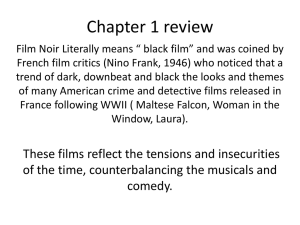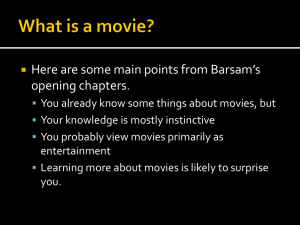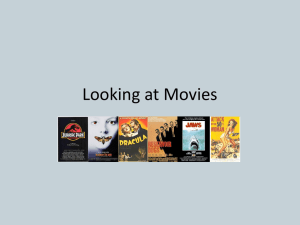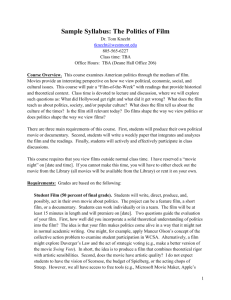Film Form
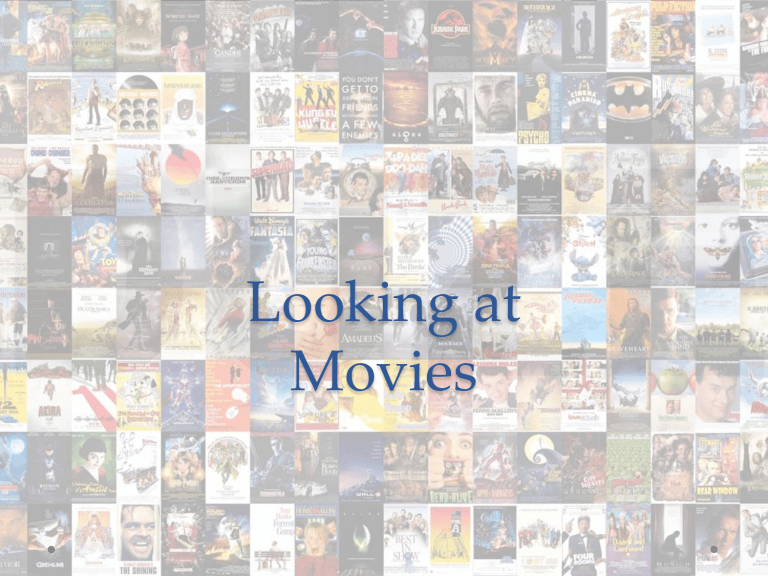
Looking at
Movies
virtually every movie employs a narrative
cultural differences affect how stories/narratives are presented
editing gives movies the power to choose what and how the viewer sees the story
in order understand a movie, there needs to be analysis
no time to analyze/ contemplate while watching audiences absorb movie meaning intuitively and instantly intuitive example: a lowangle shot…
a polished film gets rid of distractions : producing a highly manipulated artificial reality ex: cutting in on action ex: coming in at last possible moment
key to entertaining (and making $): give customers what they want
Implicit and explicit meanings
Explicit : what is the film about
Implicit: what is the movie trying to say? what does it mean? an overall message or point?
Viewer Expectations for a Film
The basic structure:
1) a clearly motivated protagonist
2) pursues a goal
3) meets obstacles in the way
4) a clear resolution your experience of a movie is affected by how a particular film manipulates these expected patterns
Formal Film analysis: analytical approach mostly concerned with film form… or the means in which the narrative is expressed dissecting the complex synthesis of cinematography, sound, composition, design, staging*, performance and editing
it’s possible to read more meaning into an included component – but know that filmmakers exploit every tool at their disposal and therefore everything is there for a reason
JUNO
Principles of
Film Form
Film Form
Remember, very little if anything, is left to chance, a movie is a highly organized and deliberately assembled
Film content: the subject of a movie (what it’s about)
Film Form : the means by which the subject of the narrative is expressed and experienced
• doesn’t just let us see the subject, lets us see it in a particular way
• explained in cinematic language: the tools and techniques that a filmmaker uses to convey meaning and mood
Works of art need both: content and form
Film Form and Expectations
Audiences will form impressions quickly, sometimes opening credits
• in Hollywood, producers and screen writers assume the audience will decide if they like/dislike a movie in the first 10 minutes
Audiences expect that most movies start with a “normal” world that is altered by a particular incident (inciting incident) compelling the protagonist to pursue a goal.
The film’s narrative structure is written around the viewer’s desire to learn the answers
• will Dorothy get back to Kansas?
• will Frodo destroy the ring?
This desire stresses the importance of the opening scene .
(American Beauty, The Shining)
Then there’s the “ McGuffin ”
- a ‘thing’ in a story that is of vital importance the characters, motivating their actions – but turns out to be less significant to the narrative than expected
(Psycho, Pulp Fiction)
Patterns in film form:
• viewers search for patterns and progressions in all art forms
• the more these meet our expectations (or contradict them in interesting ways), the more likely we are to enjoy (and analyze) them
Pattern Example Parallel Editing:
• making different lines of action appear to be happening at the same time
• creates illusion of connections = drama
(Silence of the Lambs,
No Country for Old Men )
Fundamentals of Film Form
Movies depend on light.
Light can be manipulated to create mood, reveal character, and convey meaning (esp. chiaroscuro)
(Grapes of Wrath)
Movies provide an illusion of movement.
Movies manipulate space and time in unique ways .
• can move seamlessly from one space to another or make space move or fragment time in many ways (The Matrix)
• the camera is always selecting and manipulating what is seen on the screen
• continuous record of action occurring in different locations an illusion no other art form can convey as effectively (Godfather)
• can successfully rearrange time:
Citizen Kane, Atonement,
Memento
Realism and Antirealism: not every film strives to be
“realistic”, but nearly all films attempt to immerse us in a world that is depicted convincingly
realism – est. by Lumiere brothers - view or represent things as they really are
• realism is an illusion as well antirealism – est. by Georges Melies interest in or concern for the abstract, speculative, or fantastic
Most movies are a mix today
• These last few slides will not be on the quiz…
Verisimilitude: a convincing appearance of truth.
movies are verisimilitude when they convince you that the things on the screen (people, places…) no matter how fantastic or anti-realistic they are, are real
Cinematic language – accepted systems, methods, or conventions by which the movies communicate with the viewer
• most of the individual elements carry conventional, generalized meanings – but when combined with other elements the basic meaning becomes more defined and complex
If you are asked to refer to the ‘text of a movie’, or ‘read a particular shot or scene’ - you are being asked to apply your understanding of cinematic language
The conventions that make up this language are flexible, not rules


